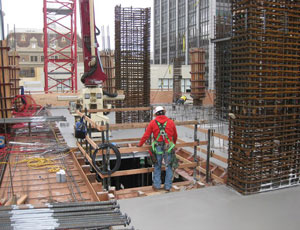As city and county officials and local trade unions work out the kinks in adhering to San Francisco’s new local hire law, which went into effect March 25, a state assemblyman from a county to the south is pushing new legislation that will shut down main elements of the ordinance.

The new San Francisco law, commissioned by Supervisor John Avalos, mandates that 20% of all project hours within each trade be performed by local residents on city/county projects in excess of $400,000. That percentage rises 5% every year until reaching 50% in 2017. In its first year, it also requires that no less than 10% of all project work hours within each trade be performed by economically disadvantaged workers, eventually rising to 25%. And, the kicker according to opponents, the ordinance will be in effect for city-funded projects within 70 miles from San Francisco.
According to a city analysis, the ordinance will cost the city/county and contractors $9.3 million annually to oversee staffing requirements. Plus, violating the law could result in fines, amounts of which have not been disclosed.
Avalos says that two of the city/county’s biggest regional projects, improvements to San Francisco International Airport (located in San Mateo County) and the Hetch Hetchy/SF Public Utilities Commission Water System Improvement Program (with projects stretching into the Central Valley and multiple counties), are exempt from the ordinance.
San Mateo County assemblyman Jerry Hill’s AB 356, currently in committee and slated for a vote later this year, would prohibit the use of state dollars on local hire projects throughout the state, including projects dubbed as local hire by San Francisco, and also limits the ordinance to only within the borders of the city and county of San Francisco.
“The Bay Area is an economically interdependent region,” says Hill. “We need to focus on creating jobs regionally, not just in each city or county.”
Avalos contends that the city/county’s 10-year-old “City’s First Source” program, which required that contractors make good faith efforts to hire 50% local residents on publically-funded projects, has not been working. He says that locals make up, on average, 20% to 25% of projects, according to a report by two local community activist nonprofits, Brightline Defense and Chinese for Affirmative Action.
“Jerry Hill's legislation is ill-informed and misguided,” says Avalos. “If he truly read the city’s local hire ordinance he would see that it actually benefits San Mateo County workers. I don't believe his bill is going anywhere because it would be opposed by assembly members representing other parts of the state that have labor agreements with local hire provisions.”
Meanwhile, local unions are not fully onboard with the new law.
Michael Theriault, secretary-treasurer of the San Francisco Building & Construction Trades Council, a coalition of 28 construction unions, says the report sent to Avalos by the local community organizations, the basis of the new law, is “shallow and shaped by preconceptions.” Plus, because of the restrictive numbers of skilled union workers (and SF residents) available as well as journey-level workers, hitting the 50% local hire mark, especially when construction gets back to normal, would be extremely difficult.
Facing penalties and waiver fees, contractors and subcontractors would boost their bids – maybe up to 15% – to cover the extra costs, which means the city/county would pay more for projects, says Andy Ball, president of Webcor Builders, San Mateo.
The Engineering & Utility Contractors Association, San Ramon, has made its members aware that certain Community Based Organizations (CBOs) have been approaching union contractors doing work in San Francisco and telling them that in order to comply with the new 10% disadvantaged local hire requirement, they need to recruit workers directly from the CBOs and not the unions.
“When it comes to hiring workers, union contractors are subject, first and foremost, to contractual obligations of the master labor agreements,” says Galina Velikovich, labor relations advocate at EUCA. “That means that when hiring in any location, including San Francisco, union contractors must contact the appropriate union local and request a dispatch of those workers who have the suitable skill set and also fit the new local hire requirements.”
One CBO that will actively be involved in the disadvantaged hiring requirements is CityBuild, which is overseen by the mayor’s Office of Economic Workforce Development. The organization offers a 12-week pre-apprenticeship program and other referral services.
“We tell contractors that CityBuild is happy to help refer qualified union workers that meet the disadvantaged definition if they desire our assistance,” says Guillermo Rodriguez, director of CityBuild. “CityBuild is not a hiring hall or a dispatch office. We assist with referrals. All contractors must work under their respective collective bargaining requirements to meet the objective.”
Ball adds that the city/county’s previous good faith measure “worked great for Webcor.”
“We totally agree with that measure and we’ve made a really strong effort to comply,” he says.
He says that on two of the biggest city projects currently under way, the General Hospital rebuild and SF Public Utilities Commission building, Webcor is meeting 42% and 35% of the previous local hire requirement, respectively, whereas the overall percentage with subcontractors is 30% and 35%.
“The problem with these types of laws is that they are passed when people aren’t working,” Ball says. “And they usually end up being laws of unintended consequences.”
Mike Purdy, a consultant of public contracting for Michael E. Purdy Associates LLC, Seattle, says whereas the city of Stockton’s 50% local hire law (passed in 2009 for projects over $100,000) is working out fine because it’s based on the good faith rule, other states and cities, such as Washington state and Cleveland, ran into trouble because of acceptance of federal and state funds and violation of Article IV (state powers) of the U.S. Constitution pertaining to the rights of out-of-state workers and contractors.

Post a comment to this article
Report Abusive Comment